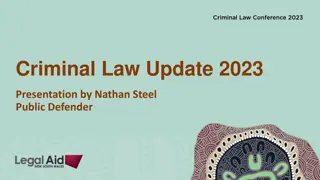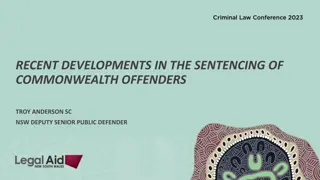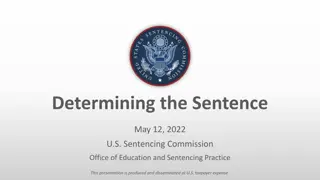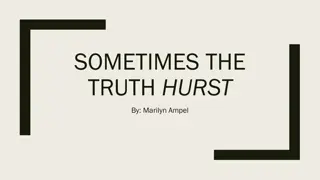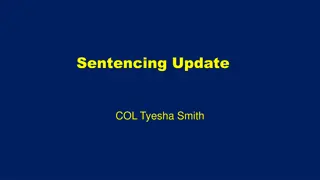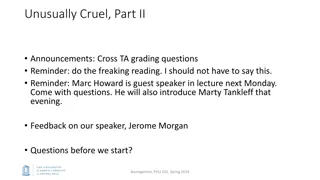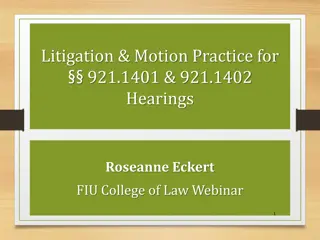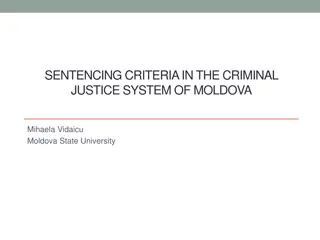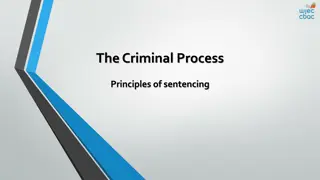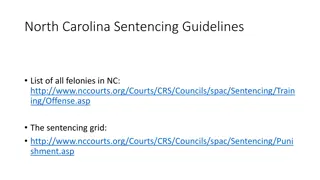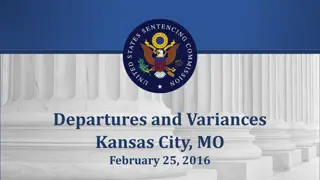Impact of Oregon's Drug Decriminalization on Sentencing Guidelines: Analysis from 2022 NASC Conference
Recent changes in Oregon's drug laws have led to significant reductions in arrests and convictions related to possession of controlled substances. These changes include shifting many drug offenses from felonies to misdemeanors, resulting in a drastic decrease in arrests and convictions since the implementation of these new laws. The data presented at the conference reflects a notable impact of Oregon's drug decriminalization on the state's sentencing guidelines.
Download Presentation

Please find below an Image/Link to download the presentation.
The content on the website is provided AS IS for your information and personal use only. It may not be sold, licensed, or shared on other websites without obtaining consent from the author. Download presentation by click this link. If you encounter any issues during the download, it is possible that the publisher has removed the file from their server.
E N D
Presentation Transcript
Impact of Oregons Drug Decriminalization on the Oregon Sentencing Guidelines 2022 NASC Annual Conference August 9, 2022 Kelly Officer Research Director Oregon Criminal Justice Commission Chris Campbell, Ph.D. Criminology & Criminal Justice Portland State University CRIMINAL JUSTICE COMMISSION STATE OF OREGON
M110 Background Recent Changes to Criminal Laws for Possession of Controlled Substances Since 2017, three substantial changes to criminal laws related to possession of controlled substances (PCS) have been passed. HB 2355 in 2017 changed PCS of user amounts for first time defendants from a felony to a misdemeanor Ballot Measure 110 in 2020 made more sweeping changes, lowering most PCS to a violation. SB 755 in 2021 made numerous technical changes to the language in the ballot measure. CRIMINAL JUSTICE COMMISSION STATE OF OREGON
M110 Background PCS Law Changes in BM 110 & SB 755 Post-Ballot Measure 110 What quantity leads to a misdemeanor? Felony Heroin: 1g LSD: 40 units MDMA: 1g or 5 pills Psilocybin: 12g Subject is convicted of a commercial drug offense Subject possess a substantial quantity of controlled substance(s) defined by 475.900(2)(b) Cocaine: 2g Methadone: 40g Methamphetamine: 2g Oxycodone: 40 pills What quantity leads to a felony? Misdemeanor Heroin: 5g LSD: 200 units Subject possesses more than a user quantity of controlled substance(s) Violation MDMA: 5g or 25 pills Psilocybin: 60g Cocaine: 10g Fentanyl : 5g All other non-felony and non-misdemeanor PCS Methamphetamine: 10g CRIMINAL JUSTICE COMMISSION STATE OF OREGON
Impacts: Data Arrest Patterns 1800 8000 Arrest Patterns While arrest patterns for PCS and non-PCS crimes followed similar trends before M110, since its passage, these trends have diverged. Between 2017 and 2019, PCS arrests averaged 1,250 per month. In April 2022, only 165 PCS arrests were logged. This represents an 87% reduction. 1600 7000 1400 HB 2355 6000 1200 5000 1000 4000 800 COVID 3000 600 2000 400 Meaure 110 1000 200 0 0 Apr-17 Apr-18 Apr-19 Apr-20 Apr-21 Apr-22 Jan-17 Jan-18 Jan-19 Jan-20 Jan-21 Jan-22 Jul-17 Oct-17 Jul-18 Oct-18 Jul-19 Oct-19 Jul-20 Oct-20 Jul-21 Oct-21 Drug PCS Arrests Non-PCS Arrests CRIMINAL JUSTICE COMMISSION STATE OF OREGON
Impacts: Data Conviction Patterns Conviction Patterns The COVID-19 impact makes it difficult to detect the true early effects of BM 110 on convictions. In 2019, Oregon averaged 165 felony and 178 misdemeanor PCS convictions per month. In May 2022, the monthly average has fallen to 31 felony and 22 misdemeanor PCS convictions. PCS Convictions 2017 through May 2022 500 450 400 350 300 250 200 150 100 50 0 Jan-18 Jan-17 May-17 Nov-17 May-18 Nov-18 Jan-19 May-19 Nov-19 Jan-20 May-20 Nov-20 Jan-21 May-21 Nov-21 Jan-22 May-22 Mar-17 Mar-18 Mar-19 Mar-21 Mar-22 Jul-17 Jul-18 Jul-19 Mar-20 Jul-20 Jul-21 Sep-17 Sep-18 Sep-19 Sep-20 Sep-21 Felony Misdemeanor CRIMINAL JUSTICE COMMISSION STATE OF OREGON
Other Impacts Community Corrections Population Community Corrections Forecast By design, BM 110 bypasses the justice system, which is resulting in both caseload and funding reductions for community corrections. April 2022 Probation Population Forecast: The forecast shows a significant dip due to COVID- 19 and Measure 110. There is a predicted rebound, however, due to new populations falling under the funded population for community corrections (see SB 497 (2021)). April 2022 Oregon Probation Population Forecast 23,000 History October 2021 April 2022 21,000 19,000 17,000 15,000 13,000 11,000 9,000 CRIMINAL JUSTICE COMMISSION STATE OF OREGON
Sentencing in Oregon Presumptive Grid Presumptive Sentencing Grid Like many states, Oregon uses a presumptive sentencing grid that provides a basic common ground for plea bargaining and intersectionality in sentencing. Index offense severity is generally provided by statutes defining the crime and if not, then by the sentencing commission. Criminal history on the grid is defined largely by the state sentencing commission. Numbers shown in the colored grid squares represent the presumptive months on the person s sentence. Criminal History Criminal History Index Index offense offense severity severity CRIMINAL JUSTICE COMMISSION STATE OF OREGON
Sentencing in Oregon Presumptive Grid Presumptive Sentencing Grid Like many states, Oregon uses a presumptive sentencing grid that provides a basic common ground for plea bargaining and intersectionality in sentencing. Index offense severity is generally provided by statutes defining the crime and if not, then by the sentencing commission. Criminal history on the grid is defined largely by the state sentencing commission. Numbers shown in the colored grid squares represent the presumptive months on the person s sentence. Those in the top portion of the grid represent presumptive months in prison. The bottom portion represents days in local control (jail). Probation terms, post-prison supervision and maximum departures are also defined in the grid, but not shown here. Criminal History Criminal History Index Index offense offense severity severity CRIMINAL JUSTICE COMMISSION STATE OF OREGON
Sentencing in Oregon Presumptive Grid Lengthier/severe criminal history Lengthier/severe criminal history Walking the Grid More severe a defendant s index offense charge is, the higher up the presumptive sentence may walk up the grid. More severe (violent) and lengthier criminal history may walk left along the grid. Includes felony or Class A misdemeanor convictions Over the person s lifetime, including felonies adjudicated as a juvenile More More severe severe index index offense offense CRIMINAL JUSTICE COMMISSION STATE OF OREGON
Possible Impacts of BM 110 on Sentencing Presumptive Grid Criminal History Criminal history Criminal history Walking the Grid When considering the impacts of BM 110, we need to consider walking the criminal history segment. PCS charges, even before 2017 defelonization, can only impact those columns that encompass non- personoffenses and Class A misdemeanors A A 3 or more person felonies over lifetime B B 2 person felonies over lifetime C C 1 person felony, and 1 or more non non- -person person felony D D 1 person felony, but no non-person felony E E 4 or more non non- -person person felonies, but no person felony F F 2 or 3 non non- -person person felonies, but no person felony G G 4 or more Class A Class A misd misd. or 1 non non- -person person felony; and no person H H No more than 3 non non- -person person felonies, and no person felony I I No felony or Class A misdemeanors No felony or Class A misdemeanors CRIMINAL JUSTICE COMMISSION STATE OF OREGON
Possible Impacts of BM 110 on Sentencing Presumptive Grid Criminal History Criminal history Criminal history Walking the Grid When considering the impacts of BM 110, we need to consider walking the criminal history segment. PCS charges, even before 2017 defelonization, can only impact those columns that encompass non- person offenses and Class A misdemeanors: Prior to 2017 Defelonization 1 PCS felony 1 PCS felony on record could feasibly move any presumptive column left by one E.g., From I to H Between 6 months in jail and 122 months in prison E.g., From E to C Between 6 months in jail and 178 months in prison A A 3 or more person felonies over lifetime B B 2 person felonies over lifetime C C 1 person felony, and 1 or more non non- -person personfelony felony D D 1 person felony, but no non-person felony E E 4 or more non non- -person personfelonies felonies, but no person felony F F 2 or 3 non non- -person personfelonies felonies, but no person felony G G 4 or more Class A Class A misd misd. or 1 non non- -person person felony felony; and no person H H No more than 3 non non- -person personfelonies felonies, and no person felony I I No No felony felony or Class A misdemeanors or Class A misdemeanors CRIMINAL JUSTICE COMMISSION STATE OF OREGON
Possible Impacts of BM 110 on Sentencing Presumptive Grid Criminal History Criminal history Criminal history Walking the Grid When considering the impacts of BM 110, we need to consider walking the criminal history segment. PCS charges, even before 2017 defelonization, can only impact those columns that encompass non- person offenses and Class A misdemeanors: Since defelonization 1 PCS misdemeanor 1 PCS misdemeanor on record could feasibly move any presumptive column left by one E.g., From I to H Between 6 months in jail and 122 months in prison Theoretically, BM 110 will not result in any grid walking A A 3 or more person felonies over lifetime B B 2 person felonies over lifetime C C 1 person felony, and 1 or more non-person felony D D 1 person felony, but no non-person felony E E 4 or more non-person felonies, but no person felony F F 2 or 3 non-person felonies, but no person felony G G 4 or more Class A Class A misd misd. or 1non-person felony; and no person H H No more than 3 non-person felonies, and no person felony I I No No felony or Class A misdemeanors Class A misdemeanors CRIMINAL JUSTICE COMMISSION STATE OF OREGON
Simulated Impacts of BM 110 on Sentencing Presumptive Grid Criminal History Simulating Retroactively Nullifying PCS Central Question Where would a defendant fall on the presumptive grid if PCS convictions were removed? Without PCS Without PCS History History PCS Most Serious PCS Most Serious Index Index With PCS History With PCS History A A 2.0% 0.2% 0.2% B B 2.6% 0.5% 0.4% C C 3.0% 1.3% 1.1% Data from Department of Corrections Convicted between 2010-2017: Height of PCS charging Sentenced to incarceration: Longest criminal history N = 24,451 individuals 7,743 (31.7%) had 1 or more misdemeanor or felony convictions for PCS 4,308 (55.6%) of those with PCS convictions had only one in their history 281 (1.2%) had PCS as most serious index offense D D 3.0% 0.0% 0.0% E E 12.8% 20.2% 16.0% F F 30.3% 16.6% 32.7% G G 38.0% 45.2% 40.2% H H 7.6% 16.0% 9.6% I I 0.8% 0.0% 0.0% Total Total 16,668 7,743 281 CRIMINAL JUSTICE COMMISSION STATE OF OREGON
Simulated Impacts of BM 110 on Sentencing Presumptive Grid Criminal History Simulating Retroactively Nullifying PCS % of Current Grid Column % of Current Grid Column n = 7,743 Central Question Where would a defendant fall on the presumptive grid if PCS convictions were removed? A A B B C C D D E E F F G G H H I I A A 100 B B 100 This table shows what percent of the current grid placement would fall along the simulated, retroactive grid. C C 80.8 D D 19.2 0.0 E E 28.4 Sim. Sim. Grid Grid F F 34.2 44.9 G G 2.2 52.5 71.5 H H 0.5 20.5 24.1 I I 35.1 1.4 2.6 16.4 0.0 Off Off 0.7 5.4 59.5 CRIMINAL JUSTICE COMMISSION STATE OF OREGON
Simulated Impacts of BM 110 on Sentencing Findings Simulating Retroactively Nullifying PCS Current Grid Current Grid n = 7,743 A A B B C C D D E E F F G G H H I I 19.2% of those who were listed as a C history, would be downgraded to D A A 100 B B 100 C C 80.8 Assuming the most severe index offense (severity=11), the prior sentence minimum (178 months) would now be the maximum (177mo) D D 19.2 0.0 E E 28.4 Sim. Sim. Grid Grid F F 34.2 44.9 G G 2.2 52.5 71.5 H H 0.5 20.5 24.1 I I 35.1 1.4 2.6 16.4 Off Off 0.7 5.4 59.5 CRIMINAL JUSTICE COMMISSION STATE OF OREGON
Simulated Impacts of BM 110 on Sentencing Findings Simulating Retroactively Nullifying PCS Current Grid Current Grid n = 7,743 71.5% listed as an E history, would be downgraded to a lower category 35.1% dropped four levels A A B B C C D D E E F F G G H H I I A A 100 B B 100 C C 80.8 Assuming a moderately severe index offense (severity=5 to 7), those previously receiving prison (E), would likely be presumptive probation (F through I). D D 19.2 0.0 E E 28.4 Sim. Sim. Grid Grid F F 34.2 44.9 G G 2.2 52.5 71.5 H H 0.5 20.5 24.1 I I 35.1 1.4 2.6 16.4 Off Off 0.7 5.4 59.5 100 CRIMINAL JUSTICE COMMISSION STATE OF OREGON
Simulated Impacts of BM 110 on Sentencing Findings Simulating Retroactively Nullifying PCS Current Grid Current Grid n = 7,743 55.1% listed as F history, would be downgraded at least 1 lower category 0.7% would no longer be on the grid A A B B C C D D E E F F G G H H I I A A 100 B B 100 C C 80.8 Assuming a lesser severe index offense (severity=3 to 5), maximum jail days (90 at severity=5) could decrease by 60 days. D D 19.2 0.0 E E 28.4 Sim. Sim. Grid Grid F F 34.2 44.9 G G 2.2 52.5 71.5 H H 0.5 20.5 24.1 I I 35.1 1.4 2.6 16.4 Off Off 0.7 5.4 59.5 100 CRIMINAL JUSTICE COMMISSION STATE OF OREGON
Simulated Impacts of BM 110 on Sentencing Findings Simulating Retroactively Nullifying PCS % of Current Grid Column % of Current Grid Column n = 7,743 2,661 (34.4%) of sample would no longer be on the presumptive grid in terms of criminal history: 5.41% formerly listed D = 1,890 defendants 59.5% formerly listed H = 771 defendants Assuming a more severe index offense (severity=8 to 11), the maximum prison sentences (134 mo) could decrease over a year. A A B B C C D D E E F F G G H H I I A A 100 B B 100 C C 80.8 D D 19.2 0.0 E E 28.4 Sim. Sim. Grid Grid F F 34.2 44.9 G G 2.2 52.5 71.5 H H 0.5 20.5 24.1 I I 35.1 1.4 2.6 16.4 0.0 Off Off 0.7 5.4 59.5 CRIMINAL JUSTICE COMMISSION STATE OF OREGON
Conclusion The impacts of M110 are varied and far-reaching The sentencing changes in M110 are not retroactive, and the impact to the Oregon Sentencing Guidelines will fade in over time At full impact, the measures appear to have a substantial impact on criminal history scores ) have been passed. CRIMINAL JUSTICE COMMISSION STATE OF OREGON CRIMINAL JUSTICE COMMISSION STATE OF OREGON


